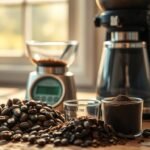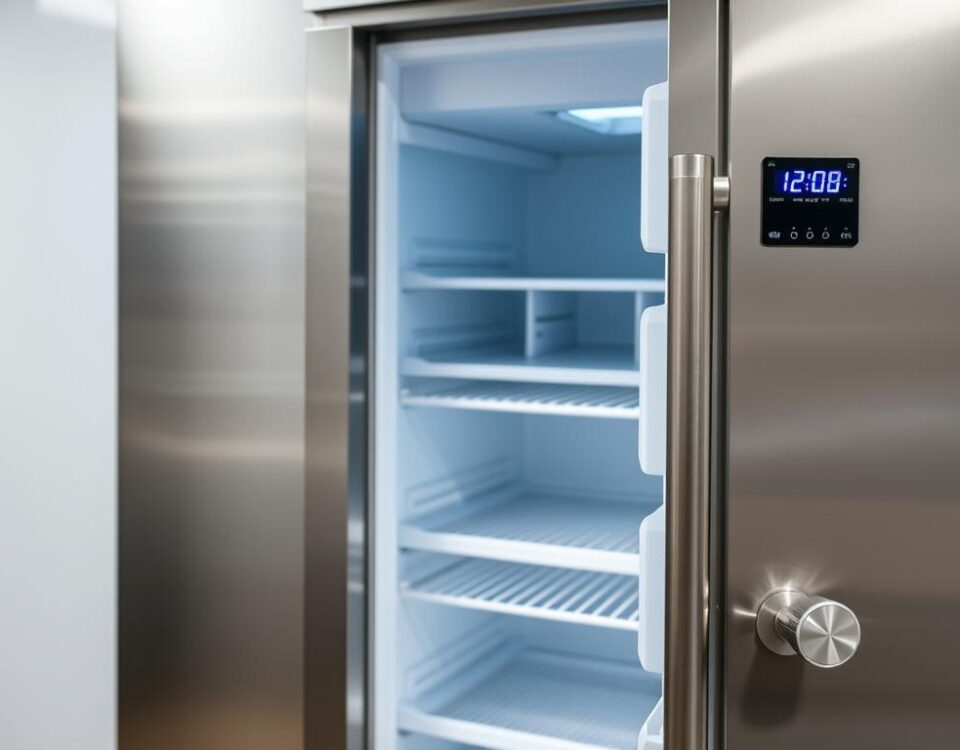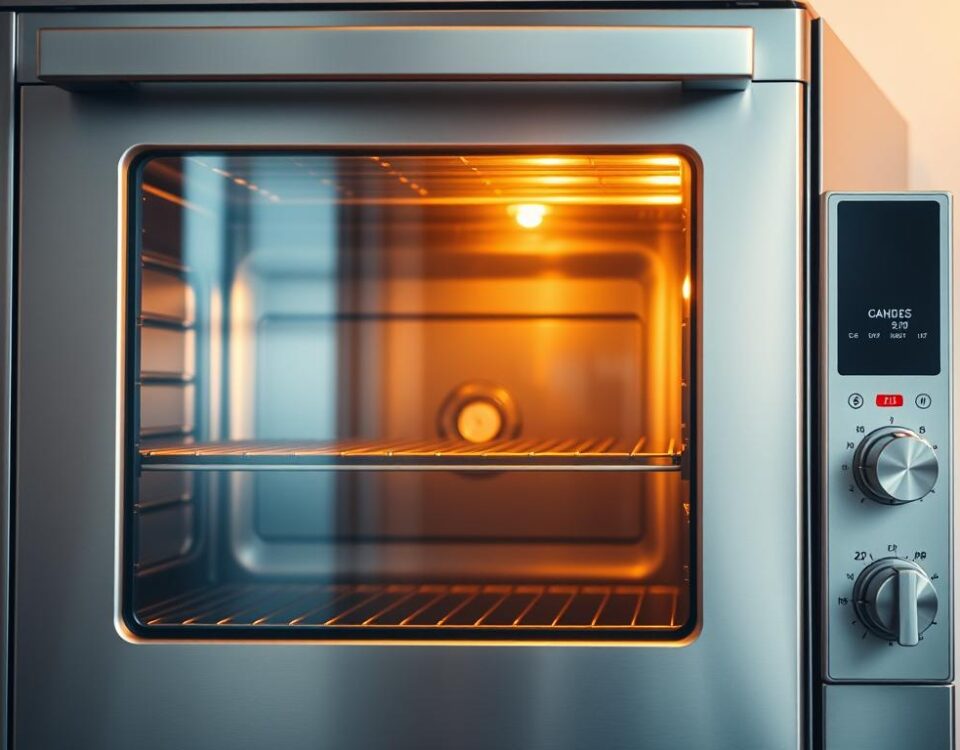
Are You Grinding Your Coffee Wrong? Find Out Now
April 19, 2025
6 Immune-Boosting Foods You Should Eat Every Day This Winter
April 19, 2025There’s something magical about that first sip of rich, velvety coffee in the morning. But for years, I thought achieving that café-quality intensity required a bulky, pricey machine. Then, one rainy weekend, I discovered a secret: you don’t need a fancy setup to craft a concentrated brew that rivals your favorite coffee shop.
I’ll never forget the day my trusty drip brewer broke. Desperate, I grabbed an old stovetop pot from the back of my cabinet. To my surprise, it created a bold, almost syrupy shot that transformed my latte game. That experiment sparked a journey into creative brewing—using tools like the AeroPress, French Press, and even a simple handheld gadget.
What I learned? It’s not about the machine. With quality beans and the right technique, you can unlock intense flavors in your kitchen. Pressure, water temperature, and grind size matter most—and I’ll show you how to master them.
Key Takeaways
- Skip costly equipment—affordable tools can create concentrated coffee.
- Technique trumps gadgets: focus on grind consistency and water heat.
- Stovetop brewers and manual devices offer surprising versatility.
- Fresh beans are non-negotiable for authentic, rich results.
- Detailed steps ahead for four proven brewing styles.
Introduction: My Journey with Espresso at Home
It all started with a failed attempt to replicate my favorite café’s signature drink using a $10 thrift store find. For months, I battled weak, bitter results that made me question if true coffee magic required a four-figure machine. Then one afternoon, a barista friend dropped truth bombs over cortados: “Pressure matters more than price tags. Your stovetop can be your best teacher.”
That conversation flipped a switch. I began treating my kitchen like a lab—testing grind sizes with a borrowed manual grinder, timing steeps with my phone’s stopwatch. Surprise MVP? A dented Moka pot I’d ignored for years. Its hissing crescendo became my morning anthem, producing liquid gold that put my old drip maker to shame.
Through burnt batches and “Eureka!” moments, three truths emerged:
- Freshly roasted beans transform even simple tools
- Water temperature needs ballet-level precision
- Every mishap teaches more than any YouTube tutorial
Now, my morning ritual involves zero fancy gadgets. Just an AeroPress, a gooseneck kettle, and beans I grind seconds before brewing. The result? A drink so layered, my former self would’ve accused me of witchcraft. Best part? You’ll need less gear than your Instant Pot collection.
The Science Behind a Perfect Espresso Shot
Mastering coffee extraction isn’t magic—it’s a dance of pressure, heat, and timing. Think of your cup as a chemistry experiment where every variable matters. Get these elements right, and you’ll unlock flavors that make your taste buds sing.

Understanding Pressure and Extraction
That rich crema? It’s born from about 130.5 PSI of pressure—the force needed to push hot water through tightly packed grounds. Manual devices like lever-style tools mimic this process. Too little force, and your shot tastes weak. Too much, and bitterness takes over.
I learned this balancing act using a handheld press. By applying steady pressure for 25-30 seconds, I achieved caramel notes I’d only tasted in cafés. The key? Consistent force throughout the brewing cycle.
The Role of Roast, Grind, and Brew Time
Dark roasts need slightly coarser grinds to prevent over-extraction. Light roasts? Go finer. Aim for grains resembling table salt. Water temperature sweet spot: 195-205°F. Too cool, and acids dominate. Too hot, and oils burn.
My morning ritual now includes a timer. Thirty seconds of contact time extracts balanced flavors—any longer, and bitterness creeps in. Adjust one variable at a time. Your perfect shot is closer than you think.
Equipment Essentials for Brewing at Home
Great coffee starts with the right toolkit—not necessarily the priciest one. After burning through three subpar grinders, I learned that precision tools make flavors pop more than any gadget’s brand name.
Must-Have Brewing Tools and Accessories
My countertop holds four non-negotiables:
| Tool | Purpose | Budget Pick |
|---|---|---|
| Conical burr grinder | Consistent grind size | Baratza Encore |
| Gooseneck kettle | Precise water flow | Fellow Stagg EKG |
| Digital scale | Accurate measurements | Timemore Black Mirror |
Blade grinders? They’re like rolling dice with your brew. My $80 burr model gave me control I didn’t know existed—suddenly, fruity notes in Ethiopian beans sang.
Choosing the Right Coffee Beans and Grinder
Freshness beats fancy origins. I buy Atlas Coffee subscriptions—roasted three days before shipping. Medium-dark roasts work best for concentrated brews.
Stale beans? They’re the silent killer of flavor. Grind right before brewing using settings finer than sea salt. Pro tip: Clean your grinder weekly. Old oils turn bitter faster than milk left in a hot car.
Espresso at home methods: A Closer Look
Brewing a concentrated coffee doesn’t require a barista’s budget—just smart techniques. Through months of trial, I’ve narrowed down four approaches that deliver bold results. Each method offers unique textures and flavors, letting you customize your morning ritual.

The AeroPress Method
This gadget became my go-to for quick brewing espresso-like shots. Use fine grounds and hot water (200°F). Stir for 10 seconds, then press slowly over 20 seconds. The pressure-driven extraction mimics traditional machines surprisingly well.
The Moka Pot Method
My stovetop hero creates intense coffee with crema-like foam. Fill the bottom chamber with water and the basket with medium-fine grounds. Medium heat builds pressure gradually—listen for the gurgle signaling your brew’s ready.
The French Press Method
While not true espresso, a 4-minute steep with extra-fine grounds yields a strong base. Plunge halfway, wait 30 seconds, then press fully. It’s my emergency option when craving depth without gadgets.
The Scientific (Coffee) Method
Here’s where I play mad scientist: adjust grind size, water ratio, and steep time. Start with 1:2 coffee-to-water, 195°F, and 45-second extraction. Log results to find your sweet spot.
| Method | Pressure Source | Brew Time | Flavor Profile |
|---|---|---|---|
| AeroPress | Manual press | 30 sec | Smooth, low acidity |
| Moka Pot | Stovetop steam | 5 min | Bold, slightly smoky |
| French Press | Immersion only | 4.5 min | Heavy-bodied |
| Scientific | Variable | Custom | Tailored to taste |
Try each style over a week—you’ll discover which balances convenience and flavor best. My Moka Pot Mondays and AeroPress Fridays keep things exciting without emptying my wallet.
Perfecting Grind, Water, and Temperature Techniques
Coffee grounds stick to my fingers like edible sand as I dial in today’s brew. Three years of daily experiments taught me this: your technique matters more than your tools. Let’s break down the two pillars of flavor alchemy.

Achieving the Right Coffee Grind Consistency
My burr grinder’s click wheel became my flavor compass. For concentrated brews, aim for grains resembling table salt—too fine, and water stalls; too coarse, and flavors stay locked in. Here’s what I learned:
| Grind Size | Texture | Best For |
|---|---|---|
| Extra Fine | Powdery | Turkish-style |
| Fine | Table salt | Moka Pot/AeroPress |
| Medium | Sand | Pour-over |
Pro tip: Clean your grinder weekly. Old oils create bitter notes faster than forgotten gym socks ferment.
Mastering Water Temperature and Pressure
195-205°F is the sweet spot—I use a $15 thermometer. Too hot, and you’ll scorch delicate flavors. Too cool, and acids dominate like overcooked lemon zest.
My pressure hack? Pour water in slow circles. This creates natural resistance, mimicking machine pumps. Combined with finely ground beans, it extracts caramelized sugars without bitterness.
| Technique | Temp Control | Pressure Source |
|---|---|---|
| Gooseneck Pour | ±2°F | Hand control |
| Preheated Brewer | Stable | Steam build-up |
Last week’s breakthrough? Timing my pour to 30 seconds exactly. The result? A shot so balanced, it made my local barista raise an eyebrow.
Mastering the Portafilter: Pulled Shots and Tamping Skills
The weight of the tamper in my palm feels like holding a sculptor’s tool—every movement shapes your coffee’s destiny. Through countless mornings, I’ve learned that precision in preparation separates murky pucks from liquid gold.

Consistent Tamping and Distribution Tips
Channeling—when water finds weak spots in your puck—ruins more shots than stale beans. My breakthrough came after watching a barista friend use the “WDT method”: stirring coffee grounds with a paperclip to break clumps before tamping. Suddenly, my extractions tasted balanced instead of bitter.
Here’s my battle-tested process:
- Dose 18-20g into your portafilter
- Distribute grounds evenly using finger sweeps
- Apply 30 lbs of downward pressure—imagine pressing a ripe avocado
- Polish with a quarter-turn twist
I keep a $10 bathroom scale in my kitchen to check tamping force. Pro tip: A naked portafilter reveals truth. When my streams started forming symmetrical honey drips instead of erratic spurts, I knew distribution was on point.
| Pressure Level | Result | Ideal For |
|---|---|---|
| 20 lbs | Under-extracted | Light roasts |
| 30 lbs | Balanced | Most blends |
| 40 lbs | Over-extracted | Rescue missions |
Timing matters too. My scale’s timer ensures I hit the 25-30 second sweet spot for espresso brewing. Miss by five seconds? You’ll taste the difference in caramel notes. Now, each step feels like conducting an orchestra—every movement harmonizing to create something greater.
Fine-Tuning the Brewing Process: Adjustments for Every Cup
Dialing in my morning brew felt like solving a delicious puzzle. Each cup became a chance to explore how tiny changes unlock new flavors. The secret? Treating every variable like a dial on a soundboard—adjust one knob, and the whole composition shifts.
Optimizing Brew Ratios and Extraction Time
My kitchen scale became my compass. A standard 1:2 coffee-to-water ratio (18g grounds to 36g liquid) creates balanced shots, but I’ve found magic in exceptions. Try these tweaks:
- 1:1.5 ratio for intense caramel notes (ideal for milk drinks)
- 1:2.5 ratio when using light roasts to highlight acidity
- 28-second extraction for medium blends vs. 32 seconds for dark roasts
Switching between espresso machines taught me adaptability. My Breville needs 19g doses, while the Gaggia prefers 17g. Pro tip: Document every adjustment. My tasting notes revealed that:
| Machine Type | Optimal Dose | Time Adjustment |
|---|---|---|
| Manual Lever | +1g | -3 seconds |
| Automatic | -0.5g | +5 seconds |
Visual cues matter. Watch your shot’s flow—honey-like streams mean perfection. Bitter aftertaste? Cut extraction 2 seconds earlier next time. Through 63 logged attempts, I discovered my goldilocks zone: 20g in, 40g out, 30 seconds. Your taste buds will guide you home.
Experimenting and Personalizing My Espresso Journey
My coffee counter became a laboratory of flavors—each morning a chance to test new theories. Through 217 cups and three burnt tongues, I discovered that taste isn’t just about recipes. It’s about curiosity and willingness to tweak every variable.
Trial, Error, and Personal Taste Adjustments
Early experiments taught me the power of amount. Doubling my coffee dose created a syrupy texture but overwhelmed subtle notes. Halving it? Thin and acidic. The sweet spot emerged at 18g—enough to balance body and complexity.
Roast levels became my flavor dial. Medium roasts offered chocolatey warmth, while light ones surprised me with floral hints. Dark blends? Perfect for cutting through milk but needed coarser grinds to avoid bitterness.
Filters transformed extraction in unexpected ways:
| Filter Type | Material | Impact |
|---|---|---|
| Paper | Bleached | Crisp, clean finish |
| Metal | Stainless steel | Richer oils |
| Cloth | Cotton | Balanced acidity |
Your perfect cup lives in the details. Try adjusting one variable weekly—grind size on Monday, water ratio on Thursday. Document results like a coffee detective. My breakthrough came when I paired Ethiopian beans with cloth filters, unlocking jasmine notes I’d never tasted before.
Embrace the mess. Some days you’ll brew liquid gold. Others? Compost fuel. Both teach you more than any textbook ever could.
Maintaining and Cleaning Your Home Espresso Setup
My morning ritual used to end with a bitter surprise—until I discovered cleaning is the secret ingredient to café-quality drinks. Neglected equipment collects stale oils that distort flavors, turning your carefully crafted cup into a murky disappointment.
Daily Care and Deep Cleaning Routines
I wipe my portafilter after each use. This prevents old grounds from affecting tomorrow’s brew. Every evening, I unscrew the shower screen—those tiny holes trap more coffee residue than subway grates.
Here’s my battle-tested system:
- Daily: Flush group head with hot water, brush baskets, dry steam wand immediately
- Weekly: Soak portafilter in Cafiza solution, descale with citric acid mix
- Monthly: Replace rubber gaskets, inspect boiler valves
That white vinegar hack? “It works,” says my local roaster, “but specialized cleaners preserve seals better.” I use a denture tablet trick for stubborn buildup—drop one in warm water overnight for sparkling filters.
My golden rule: Never skip post-brew maintenance. Leftover ground coffee becomes flavor saboteurs. Through trial and error, I’ve found these methods yield perfect espresso more reliably than any fancy gadget.
| Tool | Frequency | Pro Tip |
|---|---|---|
| Grinder burrs | Every 2 weeks | Use stiff brush, never water |
| Milk pitcher | After each use | Rinse with cold water first |
| Scale | Monthly | Q-tip cleans sensor gaps |
Consistency transforms maintenance from chore to ritual. Now, my first sip of drinks tastes like victory—not yesterday’s neglect.
Conclusion
The journey from bean to cup is paved with more experiments than a science fair. Through testing four approaches—from stovetop steam to manual presses—we’ve seen how grind consistency and water temperature trump expensive gear. Each method offers its own path to rich, layered brews that wake up your taste buds.
Remember: great results hinge on practice, not perfection. My dented Moka pot taught me more about pressure than any machine ever could. Whether you’re using an AeroPress or tweaking ratios by hand, every adjustment brings you closer to your ideal flavor profile.
Keep your toolkit simple. A quality grinder, fresh beans, and curiosity will fuel your progress. Share your discoveries with fellow enthusiasts—those “aha!” moments taste even better when celebrated together.
Stay persistent, stay playful, and let each cup remind you: craftsmanship lives in the details. Now go forth and brew something unforgettable.
FAQ
How important is pressure when brewing coffee without a machine?
Pressure helps extract rich flavors quickly. While methods like the AeroPress or Moka Pot mimic espresso-like pressure, they don’t need expensive gear. I focus on steady techniques to maximize extraction without overcomplicating things.
What’s the easiest way to start brewing café-style drinks at home?
Begin with an AeroPress or French Press. They’re affordable and forgiving. I learned that using freshly ground beans and a gooseneck kettle for water control makes a huge difference, even without fancy equipment.
Can I use pre-ground coffee for methods like the Moka Pot?
Pre-ground works, but it’s not ideal. I found that grinding beans right before brewing (with a burr grinder) unlocks brighter flavors. For a Moka Pot, aim for a consistency slightly finer than table salt.
How do I know if my grind size is right?
Test it! If your brew tastes bitter or too strong, the grind might be too fine. If it’s sour or weak, try a finer setting. My Baratza Encore grinder lets me tweak settings until I hit the sweet spot for each method.
Why does water temperature matter so much?
Too hot, and you’ll scorch the grounds; too cool, and under-extraction happens. I stick to 195–205°F (90–96°C). A simple thermometer or waiting 30 seconds after boiling helps me nail it every time.
How do I clean a French Press properly?
Rinse it immediately after use to avoid oily residue. Once a week, I disassemble it and soak the parts in warm water with Cafiza tablets. A soft brush removes stubborn bits without scratching the glass.
Can I make creamy drinks without a steam wand?
Absolutely! I froth milk with a handheld Nanofoamer or even a mason jar (shake vigorously, then microwave). Pair it with a strong AeroPress shot for a latte-like treat.
How do I adjust brew strength for different methods?
Play with ratios. For example, I use 1:15 coffee-to-water for French Press and 1:2 for Moka Pot “espresso.” Timing also matters—shorter steeps for lighter roasts, longer for darker ones.
Why does my coffee taste bitter with the AeroPress?
Over-extraction is likely the culprit. Try a coarser grind, shorter brew time (1-2 minutes), or lower water temperature. I also avoid pressing too hard—gentle pressure keeps flavors balanced.
What’s the best roast for home brewing?
Medium roasts are my go-to—they balance acidity and body. Dark roasts work well in a Moka Pot, while light roasts shine in the AeroPress. Experiment to match your taste!



